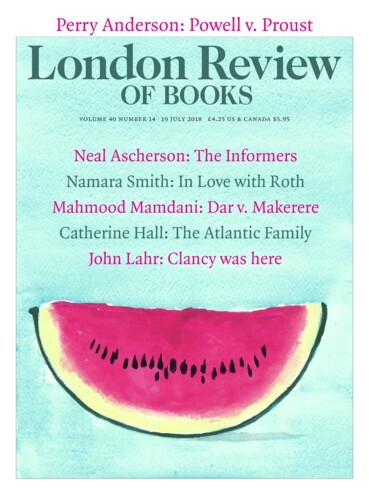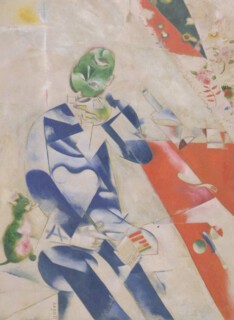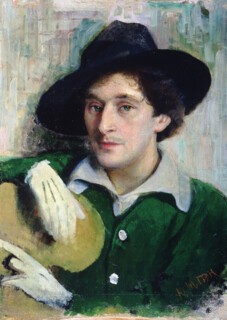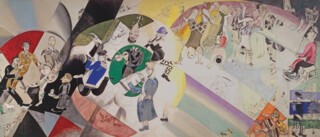Moishe Shagal , later known as Marc Chagall, was raised in the last years of the 19th century in Vitebsk, one of the shtetls in the Pale of Settlement, the part of the Russian Empire to which the Jewish population had been confined since the days of Catherine the Great. He is known as a storyteller in painting and a colourist, but in the early years of his career he was above all a Jewish artist, which means that his greatest achievement, coming from a background in which there was hardly any tradition of the visual arts, was becoming a painter at all.
Chagall was lucky: Vitebsk was home to the only art school in the Pale, run by the traditionalist Yuri Pen. But it was while studying at the progressive Zvantseva School in St Petersburg, where Léon Bakst was the drawing master, that he entered the avant garde. It was the only art school in St Petersburg ‘animated by a breath of Europe’, Chagall later wrote, thanks to Bakst and his knowledge of Post-Impressionist painting, and his work as a designer for Diaghilev. Bakst was Chagall’s route to modern painting, to the work of Cézanne, Van Gogh and Gauguin with its new knowledge of unnatural colour and form. Small paintings made after he returned to Vitebsk hang at the outset of Chagall: The Breakthrough Years 1911-19 at the Guggenheim Bilbao (until 2 September). Balancing avant-garde discoveries with a sense of home, they capture the mystery of shtetl life. His colours are artificial but never arbitrary; they are always part of the fabric and meaning of the image, soaked in, as it were. In The Yellow Room, a woman, her head inverted, sits by a table on which stand a samovar and three teacups, while a faceless man makes for the door, which leads to a burning red moonlit scene; the room is otherwise occupied by a docile cow. It is a student painting, but a very good one; the dirty yellows and artificial green glow adhere to the scene, seeming to make sense of the dancing table and the upside-down head, a motif that became Chagall’s signature.
‘When I arrived in Paris I was the colour of a potato,’ Chagall told an interviewer in 1967, meaning that he was still largely shaped by the murkiness of Russia and Central Europe. Nothing symbolised liberation more than the ‘free’ bright colour of Parisian painting. Chagall travelled to Paris in May 1911 and ended up living in a studio at La Ruche (‘the beehive’), a dilapidated, circular establishment divided into wedge-shaped studios for artists and writers, wives and lovers, memorably described by the sculptor Ossip Zadkine as a ‘sinister wheel of brie’. Chagall captures its bohemian atmosphere in his memoir:
While an offended model sobbed in the Russian ateliers, the Italian studios ran with songs and the sound of guitars, the Jewish ones with discussions, I was alone in my studio in front of my oil lamp. A studio crammed with pictures, with canvases that were not really canvases, but my tablecloths, sheets and nightshirts torn into pieces.
He paints in the nude, and cuts a herring in two, reserving the upper part for the next day. Perhaps it reminded him of his father, a herring merchant; in any case he was still, in his mind, half in Russia. Couple with a Goat, a raucous fairy tale scene showing a woman diving across a table to insert her finger into her bearded husband’s mouth, urged on for some reason by a pink-headed goat, is painted with red and black outlines, and looks more like Larionov than Picasso or the Cubist hangers-on who were exhibiting at the Salon.
It was at La Ruche that Chagall painted one of his first great works, Half-Past Three (The Poet), a large canvas (the studios at La Ruche were double-height) showing the Russian poet Mazin sitting writing at a table, his green head on upside down. The picture is built from dynamic lines around which colours gather in a sort of explosion, ignored by the pink-bellied cat pawing the poet from the left, and shows Chagall balancing the fantastical and folkloric elements of Russian art with the breezy, weightless palette of Robert Delaunay, a key friend and supporter in his years at La Ruche. Yet the closer Chagall comes to a Parisian style, the more his colour seems detached, arbitrary, edging towards decoration. He paints with rich unmixed pigments, thinned to translucency, their combinations often garish. A pure dark blue – perhaps ultramarine – is particularly unpleasant, and particularly frequent on Chagall’s palette. You long for him to mix in a smudge of white, knock the colour down, blend it in a little, make it less brash.
Even in these early years Chagall was drawn more to writers than painters (Robert Delaunay was his only real painter friend). His allegiance is recorded in the other great work from this time, the homage to Apollinaire – that ‘gentle Zeus’ – painted in 1913. Against a Delaunay-ish coloured disc stands a geometrically defined figure, split into two upper bodies, one female and one male, enacting the biblical expulsion from paradise with a firm nod toward Masaccio’s wall painting in the Brancacci Chapel. Numbers on one side of the disc reveal that it is in fact a large clock, the sort that might be found in a railway station, animated by Futurist swooshes and swirls of colour. The clock was ticking for Chagall – his fiancée, Bella Rosenfeld, wrote increasingly anguished letters from Vitebsk asking for news, wondering if he would ever come back. ‘Another year, and everything might have been over between us,’ Chagall later wrote. World events were rumbling. He left Paris early in 1914, stopping in Berlin in May for the first exhibition of his work, mounted by Herwarth Walden in his gallery Der Sturm, before returning to Russia. It was the last time he saw Apollinaire, who died four years later of the Spanish flu. It was also the last time he saw Paris in the glory days of La Ruche. War and revolution turned a three-month trip into eight years away.
Returning to small-town Vitebsk must have felt like a huge backwards step after working in a studio at the heart of the avant garde. Yet returning to the Pale was also a return to the subject that truly animated him – Jewish life – and somehow the imagined colours and the substance of the paintings reconnect. The colour begins to mean something again. In The Newspaper Vendor (1914) a newspaper seller, plying his wares against an acid orange sky, becomes an emblem of provincial gloom and poverty, the darkened greenish spires of the synagogue giving the impression of a forlorn town on the edge of a chemical works. The news is surely bad.
In the early years of the war the news certainly was bad for Jews living in the western part of the Pale, who were subject to mass expulsions. Chagall saw his post-1914 paintings of Vitebsk as documents of a world that was disappearing. He captured the ‘very last days [of] small-town, pre-revolutionary Jewish-Russian existence’, as Jackie Wullschlager puts it in her indispensable biography of Chagall.* Four large portraits of destitute old Jews dressed as rabbis are among his best paintings from the period (they have been brought together for the first time in Bilbao). The dark green face and yellow beard of Jew in Green is far from Parisian frivolity, but Chagall still uses to great effect the new vocabulary of painting, a flattened collage-like technique incorporating text, in this case Hebrew lettering. In Over Vitebsk, a figure with sack and stick drifts above the snowy town: the Wandering Jew of Chagall’s dream world.
Chagall often painted his family, but most of all Bella, whom he married in the summer of 1915. He paints and draws her with the energy and curiosity of love rediscovered: standing by a large window, playing a violin, being kissed, posing for a portrait. They fly through the air over Vitebsk, he levitates and twists to kiss her on his birthday, or, in Promenade from 1917-18, holds her hand to stop her drifting off into the clouds. These are among Chagall’s best known paintings, but not really his most successful. Parisian gaiety returns, and with it an overburdened palette and weak, overwrought compositions. In Promenade, Chagall depicts himself grinning self-consciously and made-up. He was by most accounts very vain; who else would make a painting such as The Poet Reclining (at Tate Modern, though not in Bilbao) on their honeymoon – an admiring self-portrait with no Bella in sight? He had a good-looking, if girlish face, Bella later wrote with twisting candour, ‘but it was like bitter chocolate, and, like his own paintings, slightly repellent’.
Chagall was an unlikely revolutionary but he was caught up all the same by the events in the autumn of 1917. In September 1918 Anatoly Lunacharsky, the Soviet Commissar for Culture, appointed Chagall Commissar of the Arts in Vitebsk. All he knew of Marx, he later wrote, was that he was a Jew and had a long white beard. Chagall established an art school to which he recruited anybody and everybody who might be able to wield a brush. For the celebration of the first anniversary of the Revolution, he and his students decorated the town with Chagallian images – upside-down cows, flying peasants – in a large public display of his work that rightly confused hardline officials. But it required more than topsy-turvydom to create the image of revolution. When the far cooler, politically more austere and probably very irritating Malevich showed up at Chagall’s school (he was brought by train from Moscow by El Lissitsky, already on the teaching staff), the students soon switched their allegiance. Left out in the cold, Chagall was obliged to leave.
He returned to Europe in 1922, first to Berlin, then to Paris, where he re-established himself. The postwar years were marred by bitterness; all the profits made from Herwarth Walden’s exhibition were swallowed up by hyperinflation, and Walden refused to reveal where the paintings had gone, leaving Chagall unsure if they still survived. He made copies of earlier paintings, such as the wonderful One Says: The Rabbi, a painting of a seated rabbi taking a pinch of snuff. The second version, painted more than ten years later, reproduces the original closely – he was clearly working from a photograph – but loses much of the gravity and humour of the original. (The two are shown together in Bilbao.) It was a sign of the lesser work that was to come. The view that from the mid-1920s Chagall’s work becomes awkward, illustrative, sentimental and garish can be quibbled with, but never entirely dismissed.
The elegant hang in Bilbao by the curator Lucia Aggire, and the keen selection of works by Josef Helfenstein, who originated the exhibition in Basel, makes the strongest case possible for Chagall’s greatness during these early years. But the Breakthrough Years of the title raises the obvious question – breakthrough to what? The answer is unquestionably the large paintings Chagall made in Moscow for the State Jewish Chamber Theatre, often described as his best work. He was first commissioned in late 1920 to design the set and costumes for three short plays by Sholem Aleichem, staged in a cramped auditorium in a Moscow mansion requisitioned by the Bolsheviks. Chagall decided to decorate the entire room, and produced, in a remarkably short period, eight large paintings on the walls and ceiling, dominated by the large frieze-like Introduction to the Jewish Theatre (all now in the Tretyakov Gallery in Moscow, except the ceiling painting, which didn’t survive). They were a culmination of the Jewish themes and weightless figures of the previous decade, but also, in their blanched palette, an acceptance that the Suprematists were at least in part right about colour: it was not just a decorative, but also a moral element of painting, and required control and restraint to be effective. On the wall opposite the stage hung one of the most intriguing images: a painting that is hardly commented on for being so unlike Chagall’s other work. Love on the Stage seems at first sight entirely abstract, a large, squarish field of dynamic force lines and tonal gradations more like something Malevich might have painted. But then the faint flickering outline of a couple dancing a pas de deux emerges, watched by two small figures sitting around an oil lamp in the orchestra pit below. For once Chagall goes beyond his origins into a new mysterious world of painting, a poetry of form, rather than mere subject. But then he retreated.
Send Letters To:
The Editor
London Review of Books,
28 Little Russell Street
London, WC1A 2HN
letters@lrb.co.uk
Please include name, address, and a telephone number.




